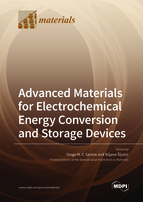Advanced Materials for Electrochemical Energy Conversion and Storage Devices
A special issue of Materials (ISSN 1996-1944). This special issue belongs to the section "Energy Materials".
Deadline for manuscript submissions: closed (30 June 2021) | Viewed by 20122
Special Issue Editors
Interests: low-temperature fuel cells; alkaline water electrolysis; electrochemical wastewater treatment
Special Issues, Collections and Topics in MDPI journals
Interests: electrocatalysis; electrochemical energy conversion and storage devices; electroanalytical chemistry
Special Issues, Collections and Topics in MDPI journals
Special Issue Information
Electrochemical energy conversion and storage is attracting special attention due to the drawbacks and limitations of existing fossil fuel-based technologies. The development of electrochemical energy conversion and storage devices has three directions: the development of batteries, development of capacitors, and development of fuel cells. Batteries are finding wide application in portable devices including laptop computers, mobile phones and cameras. Supercapacitors have the ability to accept and deliver charge at much faster rate than batteries, for many charge/discharge cycles. Fuel cells provide efficient and clean continuous power generation for both stationary and portable devices. These three technologies show promise of overcoming climate change problems caused by the use of fossil fuels. However, issues related to the electrode efficiency, membrane costs, and electrolyte stability, still limit the widespread commercialisation of batteries, capacitors and fuel cells.
The choice of electrode materials, as well as the electrolyte composition, determines the crucial electrochemical device parameters, such as specific energy and power, cycle life and safety. Accordingly, it is essential to develop the existing and introduce new procedures for the synthesis of electrode materials in batteries, capacitors and fuel cells. The development of new, improved electrocatalytic materials for batteries, capacitors, and fuel cell electrode reactions is expected to have great impact on device performance and, consequently, their commercialisation.
This Special Issue is focused on the development of electrocatalytic material for energy storage and conversion devices, including, but not limited to, the following topics:
- Theoretical screening of material properties for the tailoring of electrocatalysts;
- Novel non-platinum cathode materials for low-temperature fuel cells;
- Novel non-metal cathode materials for low-temperature fuel cells;
- Novel anode materials for alcohol fuel cells;
- Novel anode materials for direct borohydride and ammonia fuel cells;
- Novel electrode materials for sodium-ion rechargeable batteries of high efficiency;
- Novel materials for supercapacitors;
- Novel supporting materials for metal electrocatalysts for energy conversion devices;
- New trends in the synthesis procedures of materials for electrochemical energy conversion and storage devices;
- Characterisation of materials for electrochemical energy conversion and storage devices;
- Testing of novel electrode materials for lab-scale fuel cells;
- Development of novel electrolytes and membranes for electrochemical energy conversion and storage devices.
Dr. Diogo Miguel Franco dos Santos
Dr. Biljana Šljukić
Guest Editors
Manuscript Submission Information
Manuscripts should be submitted online at www.mdpi.com by registering and logging in to this website. Once you are registered, click here to go to the submission form. Manuscripts can be submitted until the deadline. All submissions that pass pre-check are peer-reviewed. Accepted papers will be published continuously in the journal (as soon as accepted) and will be listed together on the special issue website. Research articles, review articles as well as short communications are invited. For planned papers, a title and short abstract (about 100 words) can be sent to the Editorial Office for announcement on this website.
Submitted manuscripts should not have been published previously, nor be under consideration for publication elsewhere (except conference proceedings papers). All manuscripts are thoroughly refereed through a single-blind peer-review process. A guide for authors and other relevant information for submission of manuscripts is available on the Instructions for Authors page. Materials is an international peer-reviewed open access semimonthly journal published by MDPI.
Please visit the Instructions for Authors page before submitting a manuscript. The Article Processing Charge (APC) for publication in this open access journal is 2600 CHF (Swiss Francs). Submitted papers should be well formatted and use good English. Authors may use MDPI's English editing service prior to publication or during author revisions.
Keywords
- fuel cells
- batteries
- supercapacitors
- electrode materials
- electrocatalysis








